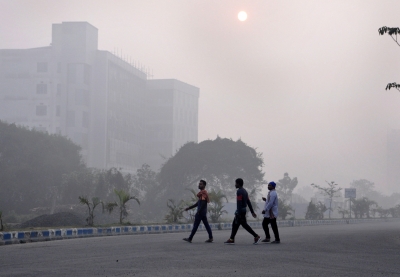Early wintry signals, upcoming Diwali season raise pollution alarm in Kolkata
As the nip in the air and the morning chill are signalling the onset of the winter season in West Bengal, apprehensions are rising over the worsening air pollution levels in Kolkata in the coming weeks.
According to experts, the chill of early winter signal is leading to a thermal inversion which holds back pollutants closer to the ground-level
The pollution levels, both air and sound, are expected to be at the worst during the span of four to five days starting from November 11, with the advent of the firecracker season on the occasion of Kali Puja and Diwali, which generally prolongs for few days in Kolkata even after the culmination of the festivities.
Environmental experts and green technologists like S.M. Ghosh feels that still there is a way to keep the air pollution levels in Kolkata within reasonable limits but only if the West Bengal Pollution Control Board (WBPCB) and Kolkata Police are serious about it.
“The first is that both WBPCB and the city police will have to ensure that only green crackers are burnt during the festival days. Secondly, these two enforcement agencies will have to ensure that the Supreme Court of India’s stipulated two-hour window for bursting firecrackers, and that too only green crackers, are adhered strictly,” Ghosh pointed out.
However, he added that going by the experiences of the citizens during the last couple of years on the occasion of Kali Puja and Diwali, it is unlikely that WBPCB and the city police will be able to enforce these two guidelines strictly and true to their spirits.
City-based environmentalists also feel that just as during the just concluded Durga Puja, the traffic police department restricted vehicular movements on several streets thus relieving the pressure of vehicles, the same thing should be applied on the occasions of Kali Puja and Diwali.
“Because of the lesser vehicular pressure during the Durga Puja days, both the PM10 and PM.25 levels in Kolkata were well within the permissible limits. However, it started worsening already with the result of vehicular pressure on the streets immediately after the Puja days were over. So if vehicular pressure is restricted during Kali Puja and Diwali also, the higher pollution resulting from firecracker bursting can be balanced to an extent by lesser auto-emission,” said Ghosh.
The strange thing, according to Ghosh and veteran environmentalist N. Dutta, the worst AQI is recorded at Victoria Memorial in central Kolkata, where Maidan — the ‘Lungs of Kolkata’ — is located.
“One an average the AQI recorded at Victoria Memorial is always 202, which is considered as poor. The heavy vehicular pressure in the roads adjacent to the lungs of Kolkata and the resulting auto-emission is one of the major reasons for it,” Ghosh said.
Environmentalists like Dipanjali Majumdar feel that feel that while automobile emission remains the dominant factor for the deteriorating AQI in Kolkata, there are other factors like open air cooking using coal- based or kerosene-gas ovens by 10,000 odd street vendors in the city, indiscriminate burning of garbage in open places in the absence of a proper garbage segregation systems and the piling of hazardous construction sites in open spaces near the under-construction real estate sites are other major contributing factors.
An additional point that is keeping the environment activists in the state worried for the forthcoming Kali Puja and Diwali is the enhanced sound pollution because of the recent decision of WBPCB to relax the decibel limit for firecrackers in the state to 125 from the earlier level of 90.
WBPCC’s logic had been that when the upper decibel limit for firecrackers has been fixed at 124 decibel by the Supreme Court, there is no justification of fixing lower decibel limit in West Bengal.
However, Ghosh has challenged this logic by pointing out that while fixing the upper decibel limit at 125, the apex court of the country gave full liberty to individual state governments to set lower decibel limits for minimizing the noise pollution if needed.
“So this relaxation in the decibel limit is nothing but twisting of the order to serve the purpose of green-cracker lobby in the state, considering that the green-crackers formulated by CSIR-NEERI are not meeting the acoustic sound level of 90 decibels, the WBPCC changed their guidelines in respect of the permissible sound limit to 125 decibels,” Ghosh pointed out.
Environmentalists also claim that noise pollution, like air pollution, is an equally a serious matter for Kolkata considering that it one of the noisiest cities in the world because of high human population density in limited space and excessive vehicular density on 6 per cent motorable roads against the city’s total geographical area.
On normal working days, the acoustic sound crosses 80 decibels in most of the city’s commercial areas and also in some residential zones because of high pitch vehicular honking and emission exhaust sound apart from public whispering..

